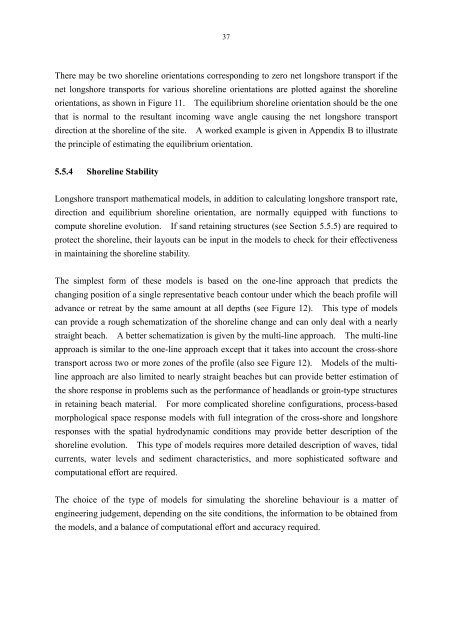PORT WORKS DESIGN MANUAL PART 5 Guide to Design of ...
PORT WORKS DESIGN MANUAL PART 5 Guide to Design of ...
PORT WORKS DESIGN MANUAL PART 5 Guide to Design of ...
You also want an ePaper? Increase the reach of your titles
YUMPU automatically turns print PDFs into web optimized ePapers that Google loves.
37<br />
There may be two shoreline orientations corresponding <strong>to</strong> zero net longshore transport if the<br />
net longshore transports for various shoreline orientations are plotted against the shoreline<br />
orientations, as shown in Figure 11. The equilibrium shoreline orientation should be the one<br />
that is normal <strong>to</strong> the resultant incoming wave angle causing the net longshore transport<br />
direction at the shoreline <strong>of</strong> the site. A worked example is given in Appendix B <strong>to</strong> illustrate<br />
the principle <strong>of</strong> estimating the equilibrium orientation.<br />
5.5.4 Shoreline Stability<br />
Longshore transport mathematical models, in addition <strong>to</strong> calculating longshore transport rate,<br />
direction and equilibrium shoreline orientation, are normally equipped with functions <strong>to</strong><br />
compute shoreline evolution. If sand retaining structures (see Section 5.5.5) are required <strong>to</strong><br />
protect the shoreline, their layouts can be input in the models <strong>to</strong> check for their effectiveness<br />
in maintaining the shoreline stability.<br />
The simplest form <strong>of</strong> these models is based on the one-line approach that predicts the<br />
changing position <strong>of</strong> a single representative beach con<strong>to</strong>ur under which the beach pr<strong>of</strong>ile will<br />
advance or retreat by the same amount at all depths (see Figure 12). This type <strong>of</strong> models<br />
can provide a rough schematization <strong>of</strong> the shoreline change and can only deal with a nearly<br />
straight beach. A better schematization is given by the multi-line approach. The multi-line<br />
approach is similar <strong>to</strong> the one-line approach except that it takes in<strong>to</strong> account the cross-shore<br />
transport across two or more zones <strong>of</strong> the pr<strong>of</strong>ile (also see Figure 12). Models <strong>of</strong> the multiline<br />
approach are also limited <strong>to</strong> nearly straight beaches but can provide better estimation <strong>of</strong><br />
the shore response in problems such as the performance <strong>of</strong> headlands or groin-type structures<br />
in retaining beach material. For more complicated shoreline configurations, process-based<br />
morphological space response models with full integration <strong>of</strong> the cross-shore and longshore<br />
responses with the spatial hydrodynamic conditions may provide better description <strong>of</strong> the<br />
shoreline evolution. This type <strong>of</strong> models requires more detailed description <strong>of</strong> waves, tidal<br />
currents, water levels and sediment characteristics, and more sophisticated s<strong>of</strong>tware and<br />
computational effort are required.<br />
The choice <strong>of</strong> the type <strong>of</strong> models for simulating the shoreline behaviour is a matter <strong>of</strong><br />
engineering judgement, depending on the site conditions, the information <strong>to</strong> be obtained from<br />
the models, and a balance <strong>of</strong> computational effort and accuracy required.

















